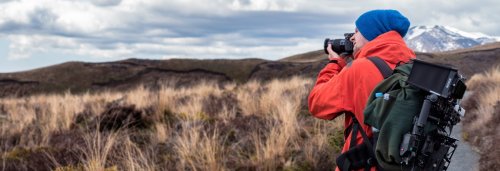How To Take A Travel Photo
Picture this: you’re on the other side of the world, surrounded by incredible scenery, eating exotic food, encountering interesting wildlife. You capture the memories in your head, but in time they will fade and you’ll forget the little details that made your trip so exciting. To truly remember everything about your travels, you will want to take a series of photographs that encapsulate your experiences.
Photographs have an uncanny knack of transporting us back to a time and place in our past. When scrolling through a series of travel photos, you will instantly remember the places that you visited, the food that you ate, the people you met and the experiences that you shared. For those of us who love to travel, taking photos along the way is an essential part of any trip if we want to look back and reminisce in years to come.
Rather than simply snapping everything that you encounter, I’ve compiled a list of nine tips to help you to take memorable travel photos, no matter how skilled you are at photography.

1. Find the right light
Quite often you will find yourself on holiday someplace hot with scorching sunshine beaming down. Bright blue skies might be perfect for sunbathing, but an abundance of bright sunshine can be tricky for taking correctly exposed photographs. Try getting up early to capture the soft light that appears just before the sun rises from beyond the horizon, or ensure that your camera is always on hand at the end of the day, during the magic hour as the sun begins to set. The light will be more diffused when the sun is lower in the sky, allowing you to capture better photographs. During the day, seek out the shadows and avoid the bright light; you’re guaranteed to take interesting shots if you notice the way the shadows fall and avoid shooting directly into the light.
2. Avoid the tourists

Your travel photographs will look much more professional and aesthetically pleasing if there isn’t a crowd of tourists clustered around the subject that you are shooting. Whether you’re visiting the Eiffel Tower for the first time or trekking to a waterfall in the Icelandic Highlands, try to beat the crowds. Avoid visiting popular tourist destinations during the late morning or in the afternoon, and try to get up at the crack of dawn to take your photos when there’s no one else around. If you find yourself in the far north of the world during the summer months, take advantage of the midnight sun and head to the main sights whilst everyone else is sleeping.
3. Consider scale
Particularly relevant if you are shooting landscapes, adding an identifier of scale to your photos can make a huge difference. Rather than simply taking a photograph of a mountain, a waterfall or a lake, ask a travel companion to stand in the frame to demonstrate the scale of the landscape. A simple trick, especially if your friend is camera-shy, is to ask them to stand in the centre of the frame, facing away from the camera and looking into the distance. You can then try several different shots, stepping further away or zooming out to fit more of the landscape into the photo.
4. Take candid snaps

It’s great to take posed shots of your travel companions and people that you encounter during your trip, but keeping your camera on hand at all times to capture candid snaps is a great way of capturing the real essence of a scene. Set your shutter speed as fast as possible and take photos of people laughing, gesturing or eating to ensure that you capture the ‘real’ moments of your holiday. Take a few steps back from your companions and look at the scene as an outsider, clicking away as many times as possible. You’ll end up with plenty of dud photos that you’ll probably delete, but there are sure to be a couple of images that capture the magic of the moment.
5. Think about angles
You’ll probably have noticed that most people’s travel photography looks exactly the same, with the majority of their photos taken at eye level. To create more interesting shots, take your time and consider different angles that will help you to see the scene from a new perspective. Squat on the floor and shoot up, get up high and shoot a scene from above, tilt your camera and shoot from a different angle. If it’s not possible to get up high, think about investing in a drone and a Go-Pro to capture your entire trip from above. Alternatively, take more time to consider the framing of your shot and try something a little out of the ordinary.
6. Capture the little details
All too often, people focus on the big landmarks and ignore the interesting details that are right in front of them. It’s easy to wander around a city, ticking off the main tourist destinations and taking obligatory ‘postcard’ photos, but you will curate a much more interesting portfolio of images if you take the time to seek out the little details. Crop your photos in tight to frame what it is that has caught your eye, be it a particular colour, texture or object. Look out for interesting signage, eye-catching patterns or objects that perfectly encapsulate your destination, such as a bike propped up outside a house in Amsterdam or a Buddha in a Chinese temple.
7. Invest in the right lens

This is a bit of a tricky one if you’re a beginner to photography, but if you have a camera with interchangeable lenses, the most important thing to consider when taking travelling photos is your choice of lens. If you will be walking around a lot, ensure that you opt for something lightweight and relatively small, such as a pancake lens, or you’ll find that you don’t take your camera out as often as you would like. Think about what you want to capture during your travels. If you’re going on safari and will be taking photos of wildlife, it’s worth investing in a telephoto zoom lens. If you’re more into portraiture and capturing the smaller details, a pancake 50mm or 35mm is ideal. For landscape photography, a wide angle lens is essential.
8. Head outside, whatever the weather
Just because it’s a rainy or cloudy day, doesn’t mean you and your camera have to stay indoors. Overcast days make for incredible moody photographs with more atmosphere, and can often make it easier to capture the feeling of a place. You’ll also find that you take much better portraits when the sky is full of clouds. Likewise with rain, just ensure that you have a protective hood for your camera to ensure it doesn’t get wet. Capturing a lighting strike above a city or a rainbow forming through a waterfall can add an extra element to your photographs.

9. Always carry your camera with you
Even if it’s inconvenient or your equipment is heavy to lug around (see, investing in the right lens), ensure that you have your camera with you at all times. You never know what you are going to stumble upon or what is going to happen that day. You could end up missing out on capturing one of the most memorable moments of your holiday, or discovering a street or landscape that you want to photograph from every angle. Ensure that you have a reliable strap and sling your camera over your shoulder, ready to reach for at every moment.
Emma Lavelle is a UK based writer and photographer and has her own blog Field and Nest.















